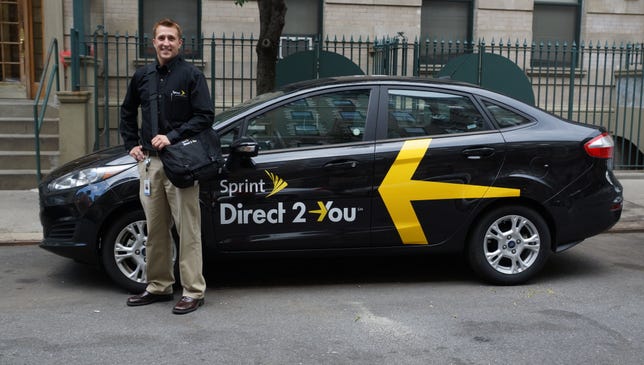
Roger Cheng/CNET
Sprint has managed to reverse its customer growth trajectory, but it wasn’t enough to fend off T-Mobile.
The Overland Park, Kansas, wireless carrier added 675,000 net new customers in the quarter that ended in July, helped by its wholesale business and a return to growth on the Sprint side. While that was a reversal from the customer losses experienced a year ago, it trailed off from the March quarter, when the company added 1.2 million new customers.
The results, however, underscore progress in the slow turnaround by Sprint as it attempts to revitalize its business in the midst of an increasingly brutal competitive field. The company has been working to improve the quality of its network and maintain the aggressiveness of its prices even as rivals amp up the pressure. While the company has improved the quality of its phone calls and the reliability of its text messages, its data speeds still lag behind the other national carriers.
Sprint is also in the midst of a transformation as it attempts to step up its game. On Monday, the company tapped a new chief financial officer and chief operating officer, and promoted one of its key executives to chief technology officer. The management shuffle is one of many changes brought on by CEO Marcelo Claure, who jumped aboard the company nearly a year ago with a mission to turn its flagging performance around.
“It’s exciting to see the company competing again as a result of our turnaround plan,” Claure said in a conference call with analysts on Tuesday.
But Sprint’s growth paled relative to T-Mobile’s addition of 2.1 million net new customers, and more than 1 million T-Mobile branded customers who pay at the end of the month, a lucrative high-credit base known as postpaid subscribers. The company ended its quarter with 58.9 million customers. T-Mobile also managed to post a stronger-than-expected profit in the period in spite of that growth.
As a result, T-Mobile overtook Sprint as the nation’s third-largest wireless carrier. Sprint ended the period with 57.7 million customers at the end of the fiscal first quarter. The company said that it added 310,000 postpaid customers and that it returned to phone growth in May and June. Like AT&T and Verizon Wireless, Sprint depended on connected devices like tablet for growth.
A company spokesman said the growth trajectory of phone customers has continued into July. “I call it an inflection point,” Claure said in an interview. “The trend continues to get better. This is not a blip.”
Overall, Sprint lost 12,000 phone customers in the July quarter, the first of its fiscal year, although it was far narrower than the 150,000 lost customers Macquarie Securities analyst Kevin Smithen had projected. Overall, the results topped his expectations.
Sprint attempted to simplify its offering by introducing an that covers the device and service cost, but ended up eliminating a popular $70 iPhone unlimited plan in lieu of a general $80 plan for all smartphones.
More troubling was the loss of 366,000 prepaid customers. That loss came as both T-Mobile and AT&T saw growth in its own prepaid services, which tend to be cheaper and force customers to pay at the beginning of each month because they often lack a high credit score. Sprint attributed the loss to customers that left Assurance, its program to offer wireless service to low-income individuals and families.
Sprint’s postpaid customer turnover rate, however, fell to 1.56 percent from 2.05 percent a year ago, an indication of increasing loyalty. While higher than its competitors, the company touts the figure as an all-time low.
The company posted a quarterly loss of $20 million, or 1 cent a share, compared with a year-earlier profit of $23 million, or 1 cent a share. Revenue fell 8.7 percent to $8.03 billion.
Analysts, on average, forecast a loss of 9 cents a share and revenue of $8.31 billion.
The company raised its full-year forecast for adjusted earnings before interest, taxes, depreciation and amortization — a sign of increasing confidence in the company’s financial health.
Sprint shares rose 6.9 percent to $3.57.
Corrected at 8:18 a.m. PT: The previous story incorrectly compared the results to the fiscal fourth-quarter results, and not the year-ago results.



